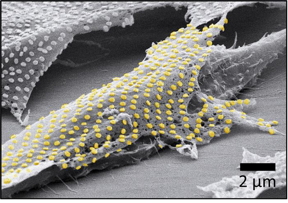Home > Press > Tattoo technique transfers gold nanopatterns onto live cells
 |
| An array of gold nanodots was tattooed onto a living fibroblast cell.
CREDIT Adapted from Nano Letters, 2023, DOI: 10.1021/acs.nanolett.3c01960 |
Abstract:
For now, cyborgs exist only in fiction, but the concept is becoming more plausible as science progresses. And now, researchers are reporting in ACS Nano Letters that they have developed a proof-of-concept technique to tattoo living cells and tissues with flexible arrays of gold nanodots and nanowires. With further refinement, this method could eventually be used to integrate smart devices with living tissue for biomedical applications, such as bionics and biosensing.
Tattoo technique transfers gold nanopatterns onto live cells
Washington, DC | Posted on August 11th, 2023
Advances in electronics have enabled manufacturers to make integrated circuits and sensors with nanoscale resolution. More recently, laser printing and other techniques have made it possible to assemble flexible devices that can mold to curved surfaces. But these processes often use harsh chemicals, high temperatures or pressure extremes that are incompatible with living cells. Other methods are too slow or have poor spatial resolution. To avoid these drawbacks, David Gracias, Luo Gu and colleagues wanted to develop a nontoxic, high-resolution, lithographic method to attach nanomaterials to living tissue and cells.
The team used nanoimprint lithography to print a pattern of nanoscale gold lines or dots on a polymer-coated silicon wafer. The polymer was then dissolved to free the gold nanoarray so it could be transferred to a thin piece of glass. Next, the gold was functionalized with cysteamine and covered with a hydrogel layer, which, when peeled away, removed the array from the glass. The patterned side of this flexible array/hydrogel layer was coated with gelatin and attached to individual live fibroblast cells. In the final step, the hydrogel was degraded to expose the gold pattern on the surface of the cells. The researchers used similar techniques to apply gold nanoarrays to sheets of fibroblasts or to rat brains. Experiments showed that the arrays were biocompatible and could guide cell orientation and migration.
The researchers say their cost-effective approach could be used to attach other nanoscale components, such as electrodes, antennas and circuits, to hydrogels or living organisms, thereby opening up opportunities for the development of biohybrid materials, bionic devices and biosensors.
The authors acknowledge funding from the Air Force Office of Scientific Research, the National Institute on Aging, the National Science Foundation and the Johns Hopkins University Surpass Program.
####
About American Chemical Society
The American Chemical Society (ACS) is a nonprofit organization chartered by the U.S. Congress. ACS mission is to advance the broader chemistry enterprise and its practitioners for the benefit of Earth and all its people. The Society is a global leader in promoting excellence in science education and providing access to chemistry-related information and research through its multiple research solutions, peer-reviewed journals, scientific conferences, eBooks and weekly news periodical Chemical & Engineering News. ACS journals are among the most cited, most trusted and most read within the scientific literature; however, ACS itself does not conduct chemical research. As a leader in scientific information solutions, its CAS division partners with global innovators to accelerate breakthroughs by curating, connecting and analyzing the worlds scientific knowledge. ACS main offices are in Washington, D.C., and Columbus, Ohio.
To automatically receive news releases from the American Chemical Society, contact .
Follow us: Twitter | Facebook | LinkedIn | Instagram
For more information, please click here
Contacts:
ACS Newsroom
American Chemical Society
Katie Cottingham
American Chemical Society
Office: 202-236-5115
Copyright © American Chemical Society
If you have a comment, please Contact us.
Issuers of news releases, not 7th Wave, Inc. or Nanotechnology Now, are solely responsible for the accuracy of the content.
News and information
![]()
Femtosecond laser technique births “dancing microrobots”: USTC’s breakthrough in multi-material microfabrication August 11th, 2023
![]()
USTC achieved dynamic imaging of interfacial electrochemistry August 11th, 2023
![]()
Simple ballpoint pen can write custom LEDs August 11th, 2023
Govt.-Legislation/Regulation/Funding/Policy
![]()
Chloride ions from seawater eyed as possible lithium replacement in batteries of the future August 11th, 2023
![]()
The present and future of computing get a boost from new research July 21st, 2023
Possible Futures
![]()
USTC achieved dynamic imaging of interfacial electrochemistry August 11th, 2023
![]()
Simple ballpoint pen can write custom LEDs August 11th, 2023
![]()
Chloride ions from seawater eyed as possible lithium replacement in batteries of the future August 11th, 2023
Nanomedicine
![]()
Detection of bacteria and viruses with fluorescent nanotubes July 21st, 2023
![]()
The picture of health: Virginia Tech researchers enhance bioimaging and sensing with quantum photonics June 30th, 2023
Discoveries
![]()
Simple ballpoint pen can write custom LEDs August 11th, 2023
![]()
Chloride ions from seawater eyed as possible lithium replacement in batteries of the future August 11th, 2023
Announcements
![]()
Simple ballpoint pen can write custom LEDs August 11th, 2023
![]()
Chloride ions from seawater eyed as possible lithium replacement in batteries of the future August 11th, 2023
Interviews/Book Reviews/Essays/Reports/Podcasts/Journals/White papers/Posters
![]()
Simple ballpoint pen can write custom LEDs August 11th, 2023
![]()
Chloride ions from seawater eyed as possible lithium replacement in batteries of the future August 11th, 2023
Nanobiotechnology
![]()
Nanonitrator: novel enhancer of inorganic nitrate protective effects, predicated on swarm learning approach May 12th, 2023
![]()
Implantable device shrinks pancreatic tumors: Taming pancreatic cancer with intratumoral immunotherapy April 14th, 2023










